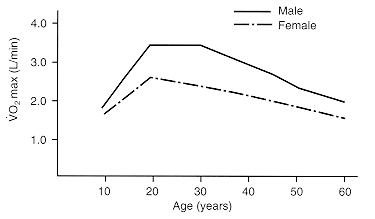| |
Age and
Gender also influence the work output of people. The curves opposite show
data on the maximum oxygen consumption rate (which is directly related to the
steady state power output) of different subjects. The power output capability
is about 20% larger for adult men than adult women, and for both genders
the peak of capability occurs between 20 and 35 years of age.
Part
of the gender difference seems to be due to the lean muscle weight, which
is less in women, and to the hemoglobin content of the blood (and hence oxygen
transport capability) which is also less in women.
|
|
|
|
|
|
|
|
|
|
|
|
|
|
| |
The magnitude
of the decline in oxygen consumption rate with age is dependent on the
general activity level of the person studied. It is greater in sedentary
people as compared to active people by a factor of three. In athletes, the time
at which the oxygen consumption rate starts to decline may also be delayed
until 40 years of age.
Estimates of the efficiency of participants
in a cycling marathon yield overall mechanical efficiencies that are between
17% and 20%. For a typical automobile, efficiencies are on the order of 15%
to 20%. In both cases, the rest of the chemical energy consumed appears as
waste heat. |
|
|
